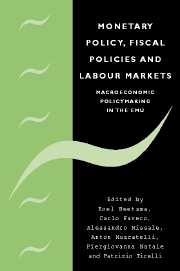Book contents
- Frontmatter
- Contents
- List of figures
- List of tables
- List of contributors
- Acknowledgements
- Editors' introduction
- Part I Monetary policy
- Part II Fiscal policies
- 5 The interaction between monetary and fiscal policies in a monetary union: a review of recent literature
- 6 Independent or coordinated? Monetary and fiscal policy in EMU
- 7 Interaction of fiscal policies in the euro area: how much pressure on the ECB?
- 8 The macroeconomic impact of different speeds of debt stabilisation in EMU
- 9 Fiscal shocks and policy regimes in some OECD countries
- 10 Monetary and fiscal policy interactions over the cycle: some empirical evidence
- Part III Labour markets
- Index
10 - Monetary and fiscal policy interactions over the cycle: some empirical evidence
from Part II - Fiscal policies
Published online by Cambridge University Press: 22 September 2009
- Frontmatter
- Contents
- List of figures
- List of tables
- List of contributors
- Acknowledgements
- Editors' introduction
- Part I Monetary policy
- Part II Fiscal policies
- 5 The interaction between monetary and fiscal policies in a monetary union: a review of recent literature
- 6 Independent or coordinated? Monetary and fiscal policy in EMU
- 7 Interaction of fiscal policies in the euro area: how much pressure on the ECB?
- 8 The macroeconomic impact of different speeds of debt stabilisation in EMU
- 9 Fiscal shocks and policy regimes in some OECD countries
- 10 Monetary and fiscal policy interactions over the cycle: some empirical evidence
- Part III Labour markets
- Index
Summary
Introduction
The advent of EMU has raised a number of issues regarding the relative roles of fiscal and monetary policy. The Stability and Growth Pact (SGP henceforth) has imposed strict limits to countercyclical fiscal policies. Whilst the SGP is seen as a tool to avoid excessive debt accumulation (see Beetsma and Jensen 1999; Beetsma and Uhlig 1997), a number of authors (see Eichengreen and Wyplosz 1998, for example) fear that the SGP will hamper the operation of automatic stabilisers.
However, there is relatively scarce evidence on the interaction of fiscal and monetary policies. Whilst considerable attention has been given to the way in which monetary authorities respond to macroeconomic conditions, much less empirical work has been done on fiscal policy. Even less attention has recently been paid to the interdependence between fiscal and monetary policy at the empirical level. The only notable exceptions are the studies by Mélitz (1997, 2000),Wyplosz (1999) and von Hagen, Hughes Hallett and Strauch (2001). For instance, using pooled data for a number of OECD economies, Mélitz (1997) finds that fiscal and monetary policy tend to move in opposite directions to each other. In other words, they are strategic substitutes. He also finds that a higher debt burden tends to trigger an adjustment process.
The present chapter extends this work in a number of directions. We use VAR models (both conventional and Bayesian VARs) to characterise fiscal-monetary interactions rather than estimating monetary and fiscal reaction functions using single-equation methods.
- Type
- Chapter
- Information
- Monetary Policy, Fiscal Policies and Labour MarketsMacroeconomic Policymaking in the EMU, pp. 256 - 296Publisher: Cambridge University PressPrint publication year: 2004
- 6
- Cited by



